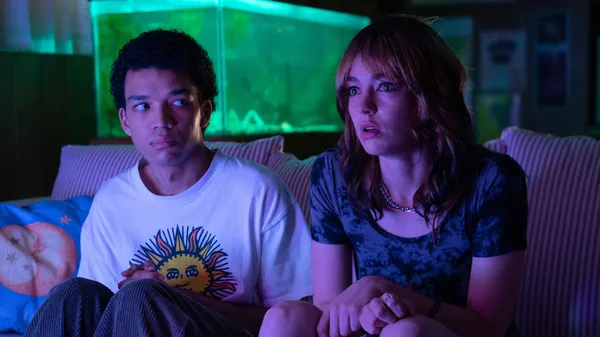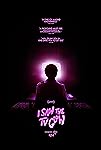Eye For Film >> Movies >> I Saw the TV Glow (2024) Film Review
I Saw the TV Glow
Reviewed by: Jeremy Mathews

It certainly wasn’t easier to follow a TV series in the Nineties compared to today, but it might have inspired more devotion. Past episodes were mythical rather than easy to watch online. Timeslots were rearranged, reruns randomly reared their ugly heads and series were unceremoniously cancelled after bone-chilling cliffhangers. In fact, a show that was on the verge of cancellation could sometimes inspire the most devotion from its small but passionate fanbase.
With I Saw the TV Glow, writer/director Jane Schoenbrun evokes this moment in culture with an unsettling, visually dazzling and curiously ominous work that seems poised to seduce the right audiences and completely baffle the wrong ones, just like one of those prematurely cancelled cult TV shows. It tells what could be a goofy story, about awkward teenagers obsessed with a TV series called The Pink Opaque, but portrays it as an ominous, nightmarish mindfuck.

Broadcast television may not seem like the most terrifying subject matter, but the movie is also about how young minds can amplify the horror of things beyond what appears on the screen. Schoenbrun’s last film, We’re All Going to the World’s Fair (2021), was about a viral interactive horror story that anyone with a YouTube account could participate in, and the long-distance relationships forged in the process. I Saw The TV Glow, which premiered at the Sundance Film Festival like World’s Fair before it, could easily be seen as a companion piece set in a different era. Here, the characters aren’t making content for the series, but they are expressing themselves through their devotion.
Owen (played by Ian Foreman as a seventh-grader and Justice Smith for the rest of the story) meets Maddy (Brigette Lundy-Paine) when both are stuck killing time in the vacant school cafeteria at night after all the other kids have gone home. Maddy, two years older than Owen, has the posture of a the ninth-grader who thinks they’ve got everything figured out. Owen notices Maddy’s book, an episode guide to The Pink Opaque, and strikes up a conversation, even though he’s never seen it beyond commercials — the show starts after his bedtime. It may be on the young adult network but it’s not a kids' show, Maddy assures Owen. The mythology is way too complicated for most kids to get it. Owen ends up conspiring to sneak to his new friend’s house to sleep over and watch the programme.
Schoenbrun taps into the mystique a series could have back in the days before you could pull up episodes at any time of the day thanks to streaming services. The recitation of the timeslot becomes more of a rhythmic, mechanical chant each time a character mentions it: Saturday night from 10:30 to 11, the last show on the young adult network before they switch to black-and-white reruns. Schoenbrun also recognises the loyalty devoted fans would show to that timeslot, whether it be for an ill-fated single-season series like Eerie, Indiana or a cult favorite-turned-hit like The X-Files, both of which seem likely inspiration for The Pink Opaque.
Smith and Lundy-Paine play their parts with detached discomfort and deep, often monotone voices. This vibe reflects their relationship, which is built more on a feeling of connection than frequent interaction. The Pink Opaque is about two young teenage girls with a psychic connection who live across town from one another but rarely meet in person, and Owen’s relationship with Maddy echoes that distance, even though they go to the same school. Without talking to him, Maddy leaves him VHS tapes of episodes so he can watch the show in spite of his bedtime.
Visually, the titular glow isn’t a singular entity or even a consistent, identifiable presence. Instead, Schoenbrun and cinematographer Eric Yue create a haunting atmosphere by casting light in the darkness in unexpected ways. Whether any of it is indicative of a supernatural entity, a dream state or campy TV monsters remains unsettlingly unclear.
The final act of the film is a lot of things, but a conventional horror conclusion is not one of them. It begins to draw even more attention to The Pink Opaque, its final episode (an unresolved cliffhanger) and whether it has any bearing on reality. What if the fading sense of awe wasn’t simply part of growing up, but part of a sinister force’s master plan?
All this plays out as a study of how media affects us, and how our minds are programmed to leave behind the things that once so thoroughly captured our attention. I Saw the TV Glow suggests that perhaps the true horror is our inability to reconnect with that sense of wonder, terror and awe that we used to be able to find anywhere, even in a young adult TV series.
Reviewed on: 30 Jan 2024

















